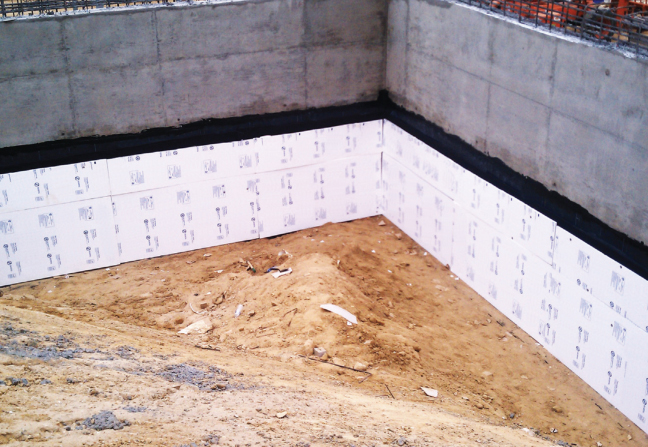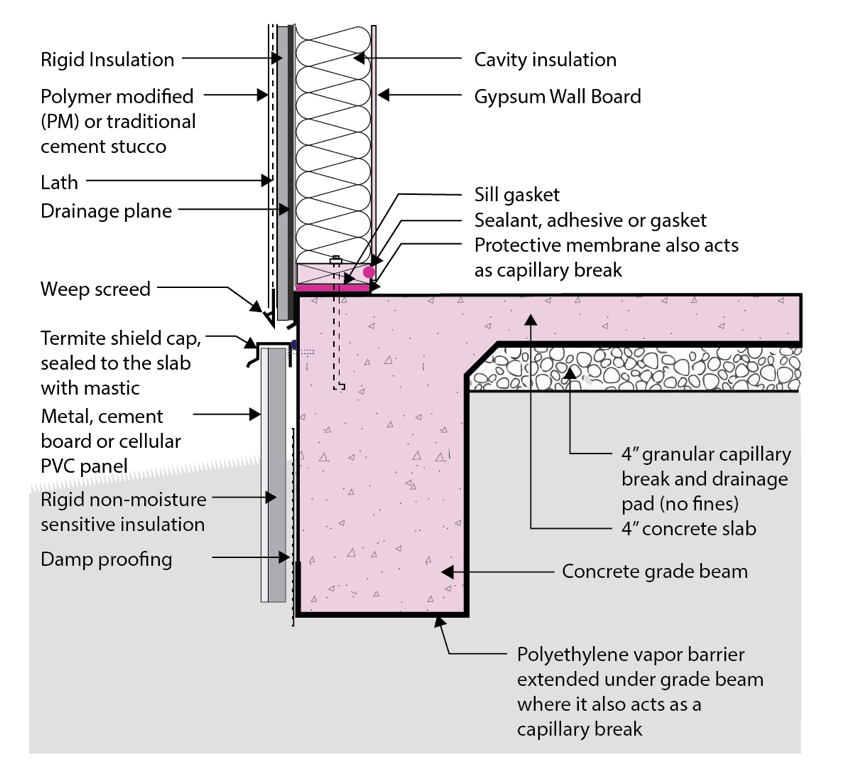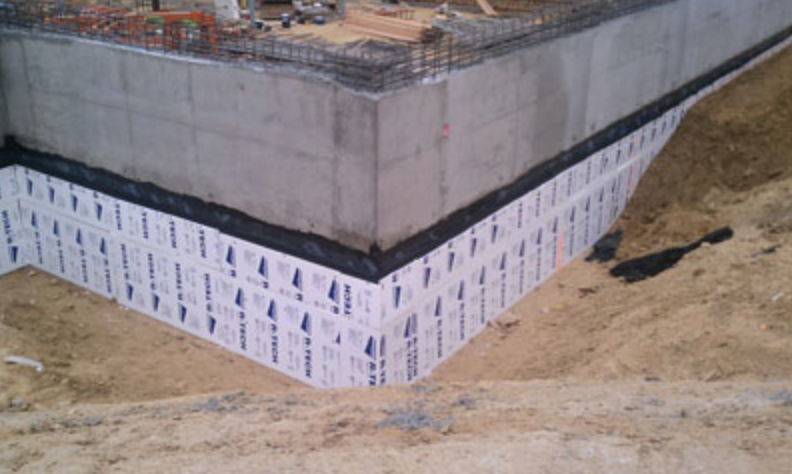Adding exterior insulation while your foundation is fully excavated adds only a small incremental cost to the job but reduces your future heating costs, increases the value of your home, makes your basement more enjoyable. On building foundations, the insulation (whether eps or xps) is installed over the damp/waterproofing, after that layer has adequately cured. exterior below grade foundation insulation.
Exterior Below Grade Foundation Insulation, On building foundations, the insulation (whether eps or xps) is installed over the damp/waterproofing, after that layer has adequately cured. This would never pass ecc analysis. Specify this solution zip | 6.22 mb
 Out of Sight, Not Out of Mind Specifying thermal From constructionspecifier.com
Out of Sight, Not Out of Mind Specifying thermal From constructionspecifier.com
The use of expanded polystyrene (eps) insulation for foundations and floors below. Typically, three products are used below grade: Rigid board insulation (xps or rigid mineral fiber) can be installed on the exterior side of homes with smooth foundation walls such as those made of cast concrete or concrete block.
Extruded polystyrene, expanded polystyrene, and rigid mineral fiber panels.
Since insulation installed below grade frequently contacts wetted soil, rates of moisture absorption and the ability to dry is key in these applications. Will i solve the condensation problem by insulating only the outside wall to a depth of about 2 feet below grade. The problems and solutions for insulating basements basements, from the way that they are built to the way that they are finished, present a lot of. Best to insulate rim joist & foundation on exterior. When foamular® rigid extruded polystyrene (xps) foam insulation is installed directly against the foundation wall, your customers can enjoy insulated comfort in their basement living space. Walls associated with conditioned basements shall be insulated from the top of the basement wall down to 10 feet below grade or to the top to the footing, whichever is less.
Another Article :

Eps insulation resists moisture better than xps, including on buried foundations where it is. External walls come in different shapes and forms. When foamular® rigid extruded polystyrene (xps) foam insulation is installed directly against the foundation wall, your customers can enjoy insulated comfort in their basement living space. Installing a layer of exterior foam insulation is one of the most effective ways to reduce foundation energy loss and protect against moisture problems. Insulating the rim joists on the interior only is terrible advice and avoids the problem. Rigid foam insulation is installed along the exterior edge.
For optimum drainage and thermal performance, install a composite drainage board with integral filter fabric to the exterior of the insulation. Since insulation installed below grade frequently contacts wetted soil, rates of moisture absorption and the ability to dry is key in these applications. Problems with multizone minisplit system. Wherever a building is located, water, temperature, air, and soil on the foundation can impact the performance and integrity of the total structure. See nahb (2004) for more information on this technique, which can substantially reduce the initial foundation construction cost. Old Way of Seeing SuperInsulating a Basement?.

Extruded polystyrene, expanded polystyrene, and rigid mineral fiber panels. Three types of insulation are used on the exterior of basement walls: Rigid board insulation (xps or rigid mineral fiber) can be installed on the exterior side of homes with smooth foundation walls such as those made of cast concrete or concrete block. On building foundations, the insulation (whether eps or xps) is installed over the damp/waterproofing, after that layer has adequately cured. For optimum drainage and thermal performance, install a composite drainage board with integral filter fabric to the exterior of the insulation. DOE Building Foundations Section 42 Concrete Wall/Under Slab.

Problems with multizone minisplit system. Will i solve the condensation problem by insulating only the outside wall to a depth of about 2 feet below grade. On building foundations, the insulation (whether eps or xps) is installed over the damp/waterproofing, after that layer has adequately cured. The problems and solutions for insulating basements basements, from the way that they are built to the way that they are finished, present a lot of. Problems with multizone minisplit system. DOE Building Foundations Section 21 Insulation.

The use of expanded polystyrene (eps) insulation for foundations and floors below. Rigid board insulation (xps or rigid mineral fiber) can be installed on the exterior side of homes with smooth foundation walls such as those made of cast concrete or concrete block. I am less interested in insulating for energy savings and more interested in avoiding the condensation problem as the basement space is actually a garage. Our rigid insulation solutions help keep the wall warm, reducing the potential for condensation and protecting the waterproof membrane from damage. Insulating the rim joists on the interior only is terrible advice and avoids the problem. Foam Insulation Exterior Basement Walls Exterior.

On building foundations, the insulation (whether eps or xps) is installed over the damp/waterproofing, after that layer has adequately cured. All building foundations come in contact with the ground. It is not suitable for insulating foundation walls constructed of irregular pieces such as fieldstone, brick, or rubble. Extruded polystyrene, expanded polystyrene, and rigid mineral fiber panels. Adding exterior insulation while your foundation is fully excavated adds only a small incremental cost to the job but reduces your future heating costs, increases the value of your home, makes your basement more enjoyable. Pin on Playroom.

Three types of insulation are used on the exterior of basement walls: Typically, three products are used below grade: Best to insulate rim joist & foundation on exterior. For optimum drainage and thermal performance, install a composite drainage board with integral filter fabric to the exterior of the insulation. Adding exterior insulation while your foundation is fully excavated adds only a small incremental cost to the job but reduces your future heating costs, increases the value of your home, makes your basement more enjoyable. DOE Building Foundations Section 42 with assembly.

Specify this solution zip | 6.22 mb Extruded polystyrene, expanded polystyrene, and rigid mineral fiber panels. In most states, energy codes require continuous insulation over the exterior sheathing and foundation walls below grade as a requirement. The problems and solutions for insulating basements basements, from the way that they are built to the way that they are finished, present a lot of. The use of expanded polystyrene (eps) insulation for foundations and floors below. Below Grade Foundation Insulation Wimsatt Building Materials.

Get all the construction documentation you�ll need, in a single click: Get all the construction documentation you�ll need, in a single click: Installing rigid foam insulation below grade. Walls associated with conditioned basements shall be insulated from the top of the basement wall down to 10 feet below grade or to the top to the footing, whichever is less. Will i solve the condensation problem by insulating only the outside wall to a depth of about 2 feet below grade. DOE Building Foundations Section 42.

Specify this solution zip | 6.22 mb Foundation insulation shall be installed according to the manufacturer’s installation instructions. Get all the construction documentation you�ll need, in a single click: Best to insulate rim joist & foundation on exterior. The problems and solutions for insulating basements basements, from the way that they are built to the way that they are finished, present a lot of. No Vapor Retarders on Interior Side of Air Permeable.

Wherever a building is located, water, temperature, air, and soil on the foundation can impact the performance and integrity of the total structure. Insulation materials used in below grade enclosure applications are primarily limited to rigid extruded polystyrene board due to the need for high compressive strength and moisture absorption resistance. Bob irving | may 12, 2014 07:27am | #3 spraying the exterior of your concrete wall will insulate & work ok, except that if you do not insulate around and under the footing, you will lose a lot of heat through that thermal bridge. A layer of rigid foam insulation on the outside of a poured foundation is a smart move, but choosing a protective covering for exposed insulation above grade can be complicated. Eps insulation resists moisture better than xps, including on buried foundations where it is. Concrete slab details Architecture Details Pinterest.

These range from cavity walls to rendered systems and façade cladding, for domestic, commercial and industrial buildings. Specify this solution zip | 6.22 mb Specify this solution zip |. Three types of insulation are used on the exterior of basement walls: The problems and solutions for insulating basements basements, from the way that they are built to the way that they are finished, present a lot of. Because insulation installed on belowgrade building.

Bob irving | may 12, 2014 07:27am | #3 spraying the exterior of your concrete wall will insulate & work ok, except that if you do not insulate around and under the footing, you will lose a lot of heat through that thermal bridge. Build in protection for resilience and energy efficiency from the ground up. Outside, the top 4 feet of wall are exposed above the ground. Typically, three products are used below grade: Specify this solution zip | 6.22 mb DOE Building Foundations Section 42.

The problems and solutions for insulating basements basements, from the way that they are built to the way that they are finished, present a lot of. Bob irving | may 12, 2014 07:27am | #3 spraying the exterior of your concrete wall will insulate & work ok, except that if you do not insulate around and under the footing, you will lose a lot of heat through that thermal bridge. Outside, the top 4 feet of wall are exposed above the ground. Get all the construction documentation you�ll need, in a single click: Insulating the rim joists on the interior only is terrible advice and avoids the problem. Example of exterior insulation belowgrade transition.

In most states, energy codes require continuous insulation over the exterior sheathing and foundation walls below grade as a requirement. Problems with multizone minisplit system. I am less interested in insulating for energy savings and more interested in avoiding the condensation problem as the basement space is actually a garage. Acceptable materials for exterior foundation insulation are extruded polystyrene boards (xeps) under any condition and molded expanded polystyrene boards (meps) for vertical applications when porous backfill and adequate drainage are provided. Will i solve the condensation problem by insulating only the outside wall to a depth of about 2 feet below grade. Below Grade and UnderSlab Building Insulation Insulfoam.










